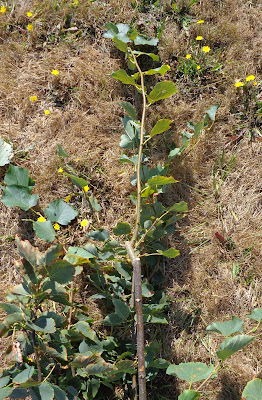I'm not saying here when my birthday is. Not into that. Even so, this year I wanted to plant a tree to thank the Earth for atmosphere and nutrition, and pay it forward a little to the next generation. I did some research. Usually I would select a Ginkgo biloba. This time I went for something a little different for me, a
Tilia cordata.
T. cordata goes by the alternative name of Little Leaf Linden, as opposed to Big Leaf Lindens. In some parts of Europe it is called a Lime, although
T. cordata is not a citrus, does not bear fruit, and is not related to limes.
All images here are from wikimedia commons.
Fossil leaf, not
Tilia cordata but still recognizable as a Linden leaf. The species,
cordatarefers to the heart shaped leaf. For a tree to be my birthday tree, a fossil leaf is a big plus.
Lindens are said to have edible leaves. I've never tasted one, and will wait for fresh spring leaves before trying. In addition, the flowers are highly fragrant, and attract bees who make a tasty famous Linden honey. The wood was used for making fiber, the term being Bast, resulting in Lindens being referred to as Basswood trees. That is what my Dad called Lindens. I think Basswood refers to the large leafed, American Linden.
Some Lindens live to a great old age, hundreds, even a thousand years. This is the Old Kasberger Lime tree, believed to be 1,000 years old. In decline, but at a thousand years, who wouldn't be?
From wikimedia commons. During the Middle Ages, communities met under large Linden trees, and there were trials and hangings. Not so good, but not the tree's fault.
Lindens were widely used to line grand avenues in Europe, in the 17th and 18th centuries. This was the old "Lindenallee" in Berlin. Still there, but newer trees,
unter den Linden.
A poem, the Linden Tree (Der Lindenbaum),
in translationby Walter A. Aue :
The Linden Tree
by Wilhelm Müller:
*
At wellside, past the ramparts,
there stands a linden tree.
While sleeping in its shadow,
sweet dreams it sent to me.
*
And in its bark I chiseled
my messages of love:
My pleasures and my sorrows
were welcomed from above.
*
Today I had to pass it,
well in the depth of night -
and still, in all the darkness,
my eyes closed to its sight.
*
Its branches bent and rustled,
as if they called to me:
Come here, come here, companion,
your haven I shall be!
*
The icy winds were blowing,
straight in my face they ground.
The hat tore off my forehead.
I did not turn around.
*
Away I walked for hours
whence stands the linden tree,
and still I hear it whisp'ring:
You'll find your peace with me!
Linden flower tea is used in some places as a remedy for respiratory ailments. I have no idea if it's a helpful remedy for anything, just that it is used.
Linden wood is finely grained, and was used for fine carving such as this one by
Grinling Gibbons in the late 1600s - early 1700s.
Here is the Linden tree that I bought. I know this is not the best time of year. I'll post separately about the pros and cons of buying and planting trees now, but in the end it is what it is, and I hope it survives and grows. There weren't many choices - just this and one other. This was the taller of the two by far. Good price.
The top was forked. This is the only thing I pruned. Too high to reach, once planted. Easy with the tree laying down on the grass. This small amount of corrective pruning will prevent the tree from having narrow fork, which weakens the tree and makes it susceptible to splitting in the future.
Just some minor surgery. I kept the most vertical looking top. The fork was 3-way. I pruned of the smallest and the least vertical.
The roots wound around the tub a bit. Not as bad as I expected. There are two main approaches to keeping this size tree for sale. One is balled and burlapped, which are placed in tubs with compost. By this time of year, it's difficult to get the roots free of the burlap and compost. The other method is placing bare root trees in compost. That is what was done here. This is a good reason to get trees in the spring, before roots have grown through the compost, but I think we will be OK with careful planting and thorough watering.
I removed as much of the compost as I could, without too much root damage, so the roots would be in the native soil, and not winding around in a hole that is filled with compost.
And here we are. Planted, post placed to keep the tree vertical in the wind, ready to be mulched, watered, and, I hope, given a good chance to settle in. Digging the hole in dry soil was hard work. Plus we have a lot of rocks. Even so, it's therapeutic and a labor of love. Few understand this. It's puttering meditation, and sweat medication. The sore back and achy hands are good sore and good achy. I'm proud, and I hope my tree lives and grows and thrives.
After this photo, I did make a little levee from the removed sod, around the tree, watered thoroughly, and mulched with compost from the original container. Before planting I had also filled the hole with water and let it drain into the surrounding soil, for reserve moisture.



















